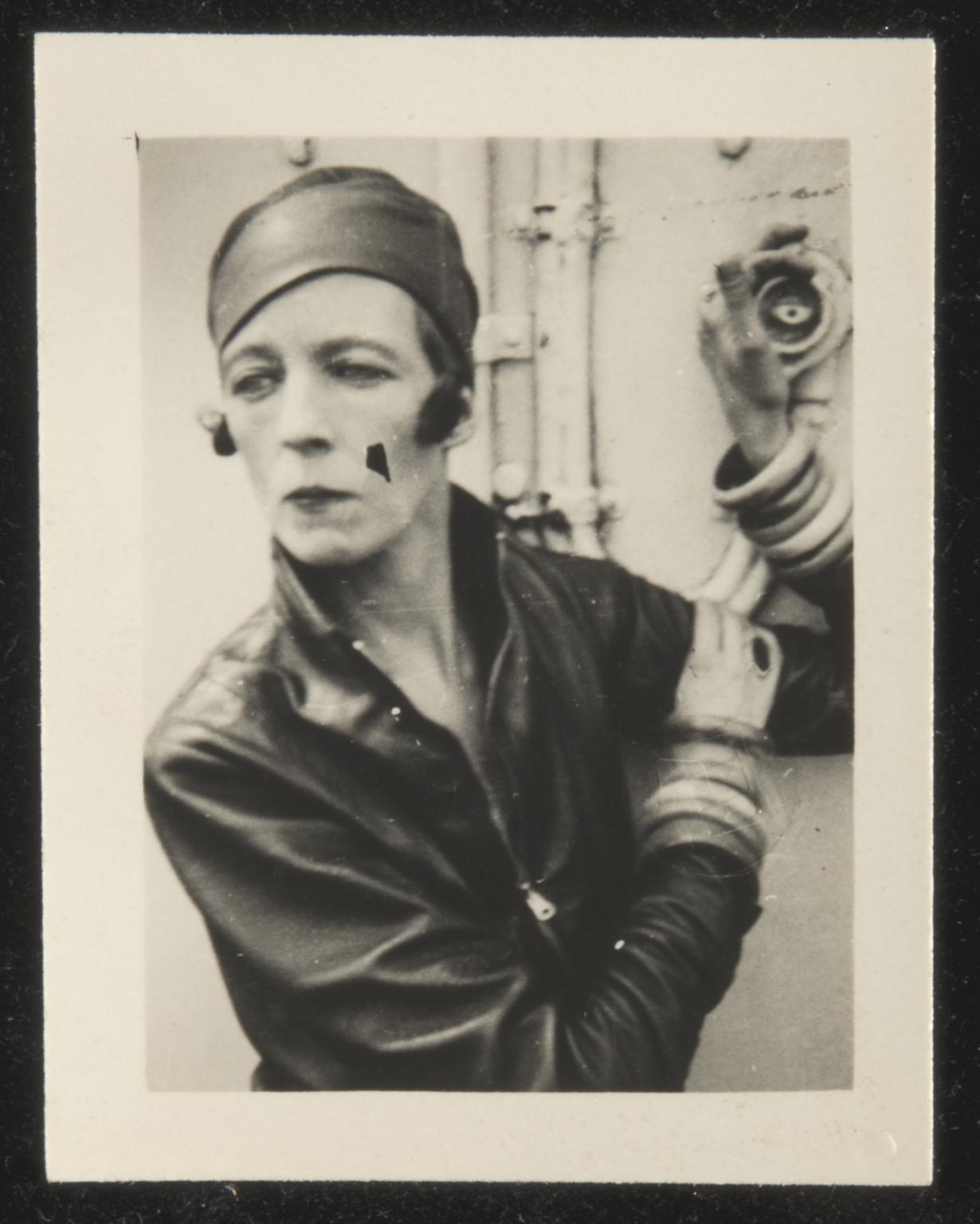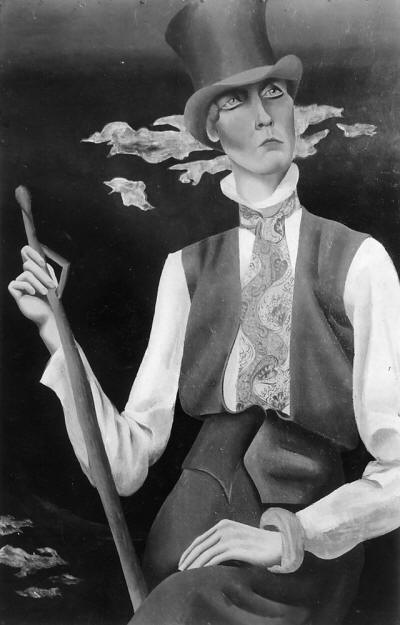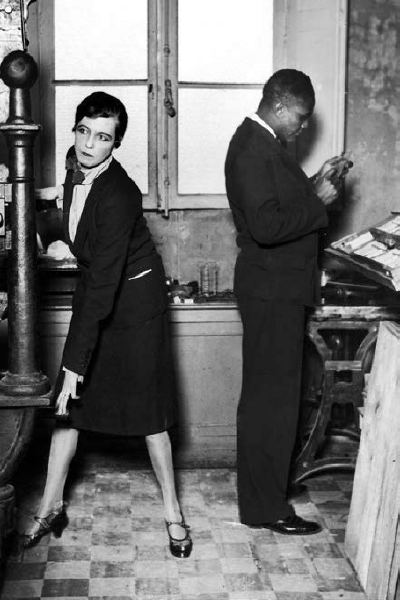

Queer Places:
Nevill Holt Hall, Nevill Holt, Market Harborough LE16 8EG, UK
Père-Lachaise, 16 Rue du Repos, 75020 Paris, France
 Nancy Clara Cunard (10 March 1896 – 17 March 1965) was a writer,
heiress and political activist. She was contacted by
Emma Goldman, with English poet
Brian Howard’s help, to support the Spanish anarchists.
Nancy Clara Cunard (10 March 1896 – 17 March 1965) was a writer,
heiress and political activist. She was contacted by
Emma Goldman, with English poet
Brian Howard’s help, to support the Spanish anarchists.
Cunard was born into the British upper class and devoted much of her life to fighting racism and fascism. She became a muse to some of the 20th century's most distinguished writers and artists, including Wyndham Lewis, Aldous Huxley, Tristan Tzara, Ezra Pound and Louis Aragon, who were among her lovers, Ernest Hemingway, James Joyce, Constantin Brâncuși, Langston Hughes, Man Ray, and William Carlos Williams. MI5 documents reveal that she was involved with Indian socialist leader VK Krishna Menon. In later years, she suffered from mental illness, and her physical health deteriorated. She died at age 69, weighing only 26 kg (57 pounds), in the Hôpital Cochin, Paris.
Her father was Sir Bache Cunard, an heir to the Cunard Line shipping businesses, interested in polo and fox hunting, and a baronet. Her mother was Maud Alice Burke an American heiress, who adopted the first name Emerald and became a leading London society hostess. Nancy had been brought up on the family estate at Nevill Holt, Leicestershire but when her parents separated in 1911 she moved to London with her mother. Her education was at various boarding schools, including time in France and Germany. Whilst in London she spent a good deal of her childhood with her mother's long time admirer, the novelist George Moore. Indeed, it was even rumoured that Moore was her father, and though this has been largely dismissed, there is no question that he played an important role whilst she was growing up. She would later write a memoir about her affection for 'GM'.
On 15 November 1916 she married Sydney Fairbairn, a cricketer and army officer who had been wounded at Gallipoli. After a honeymoon in Devon and Cornwall they lived in London in a house given to them by Nancy's mother as a wedding present. The couple separated in 1919 and divorced in 1925.[1]

Nancy Cunard by Eugene McCown

British heiress Nancy Cunard and
her lover, American musician Henry
Crowder, in Paris, 1930. © Keystone-
France/Gamma-Keystone/Getty Images
At this time she was also on the edge of the influential group The Coterie, associating in particular with Iris Tree.
She contributed to the anthology Wheels, edited by the Sitwells, for which she provided the title poem; it has been said that the venture was originally her project.
Cunard's lover Peter Broughton-Adderley was killed in action in France less than a month before Armistice Day.[2] Many who knew her claimed that she never fully recovered from Adderley's loss.
In 1920 Nancy Cunard moved to Paris, where she became involved with literary Modernism, Surrealists and Dada and frequented the Salon of Natalie Clifford Barney. Much of her published poetry dates from this period. During her early years in Paris, she was close to Michael Arlen.
Also in 1920 she had a near-fatal hysterectomy, for reasons that are not entirely clear. She recovered however, and was then able to lead a promiscuous sexual life without the inconvenience of pregnancy.[3]
A brief relationship with Aldous Huxley influenced several of his novels. She was the model for Myra Viveash in Antic Hay (1923) and for Lucy Tantamount in Point Counter Point (1928).[4]
It has been suggested that she became dependent on alcohol at this time, and may have used other drugs.[5]
Cunard's style informed by her devotion to the artifacts of African culture was startlingly unconventional. The large-scale jewelry she favored, crafted of wood, bone and ivory, the natural materials used by native crafts people, was provocative and controversial. The bangles she wore on both arms snaking from wrist to elbow were considered outré adornments, which provoked media attention, visually compelling subject matter for photographers of the day. She was often photographed wearing her collection, those of African inspiration and neckpieces of wooden cubes, which paid homage to the concepts of Cubism. At first considered the bohemian affectation of an eccentric heiress, the fashion world came to legitimize this style as avant-garde, dubbing it the "barbaric look." Prestigious jewelry houses such as Boucheron created their own African-inspired cuff of gold beads. Boucheron, eschewing costly gemstones, incorporated into the finished creation green malachite and a striking purple mineral, purpurite, instead. It exhibited this high-end piece at the Exposition Coloniale in 1931.[6]
In 1927, Cunard moved into a farmhouse in La Chapelle-Réanville, Normandy. It was there in 1928 that she set up the Hours Press. Previously the small press had been called Three Mountains Press and run by William Bird, an American journalist in Paris, who had published books by its editor from 1923, Ezra Pound, William Carlos Williams' The Great American Novel, Robert McAlmond and Ernest Hemingway's In Our Time. Cunard also wanted to support experimental poetry and provide a higher-paying market for young writers; her inherited wealth allowed her to take financial risks that other publishers could not. Hours Press became known for its beautiful book designs and high-quality production.[7]
It brought out the first separately published work of Samuel Beckett, a poem called Whoroscope (1930), Bob Brown's Words, and Pound's A Draft of XXX Cantos. Cunard published old friends like George Moore, Norman Douglas, Richard Aldington, Arthur Symons and Henry-Music, a book of poems from various authors with music by Henry Crowder, but also two books by Laura Riding, The Collected Poems of John Rodker, poems by Roy Campbell, Harold Acton, Brian Howard, Walter Lowenfels and Words by Bob (Robert Carlton) Brown. By 1931 Wyn Henderson had taken over day-to-day operation of the press and in the same year it published its last book, The Revaluation of Obscenity by sexologist Havelock Ellis.[8]
In 1928 (after a two-year affair with Louis Aragon) she began a relationship with Henry Crowder, an African-American jazz musician who was working in Paris. She became an activist in matters concerning racial politics and civil rights in the USA, and visited Harlem. In 1931 she published the pamphlet Black Man and White Ladyship, an attack on racist attitudes as exemplified by Cunard's mother, whom she quoted as saying "Is it true that my daughter knows a Negro?"[9] She also edited the massive Negro Anthology, collecting poetry, fiction, and nonfiction primarily by African-American writers, including Langston Hughes and Zora Neale Hurston.[10] It also included writing by George Padmore and Cunard's own account of the Scottsboro Boys case. Press attention to this project in May 1932, two years before it was published, led to Cunard's receiving anonymous threats and hate mail, some of which she published in the book, expressing regret that "[others] are obscene, so this portion of American culture cannot be made public."
In the mid-1930s she took up the anti-fascist fight as well, writing about Mussolini's annexation of Ethiopia and the Spanish Civil War. She predicted, accurately, that the "events in Spain were a prelude to another world war". Her stories about the suffering of Spanish refugees became the basis for a fundraising appeal in the Manchester Guardian. Cunard herself helped deliver supplies and organize the relief effort, but poor health – caused in part by exhaustion and the conditions in the camps – forced her to return to Paris, where she stood on the streets collecting funds for the refugees.[10]
Janet Flanner was for many years a close friend and strong supporter of Nancy Cunard; she approved of Cunard’s politics, her publishing ventures, and her poetry. When Cunard’s massive study of black culture, Negro, was published in 1934, Flanner gave it careful attention, cataloguing its complex research and hailing it as an important contribution to political sociology.
In 1937, she published a series of pamphlets of war poetry, including the work of W. H. Auden, Tristan Tzara and Pablo Neruda. Later the same year, together with Auden and Stephen Spender, she distributed a questionnaire about the war to writers in Europe; the results were published by the Left Review as Authors Take Sides on the Spanish War.[11]
The questionnaire to 200 writers asked the following question: "Are you for, or against, the legal government and people of Republican Spain? Are you for, or against, Franco and Fascism? For it is impossible any longer to take no side."
There were elicited 147 answers, of which 126 supported the Republic, including W.H. Auden, Samuel Beckett and Rebecca West.[12][13]
Five writers explicitly responded in favor of Franco: they were Evelyn Waugh, Edmund Blunden,[13] Arthur Machen, Geoffrey Moss and Eleanor Smith.[14]
Among sixteen responses that Cunard, in her eventually published compendium, grouped under the skeptical heading "Neutral?" were H.G. Wells, Ezra Pound, T. S. Eliot[13] and Vera Brittain.[15]
The most famous response was not included: it came from George Orwell, and began:
Will you please stop sending me this bloody rubbish. This is the second or third time I have had it. I am not one of your fashionable pansies like Auden or Spender, I was six months in Spain, most of the time fighting, I have a bullet hole in me at present and I am not going to write blah about defending democracy or gallant little anybody... .[16]
Several other writers also declined to contribute, including Virginia Woolf, Bertrand Russell,[12] E. M. Forster,[17] and James Joyce.[18]
During World War II, Cunard worked, to the point of physical exhaustion, as a translator in London on behalf of the French Resistance.
After the war, she gave up her home at Réanville and travelled extensively. She suffered from mental illness and poor physical health, worsened by alcoholism, poverty, and self-destructive behaviour.[10] She was committed to a mental hospital after a fight with London police; but, after her release, her health declined even further, and she weighed less than sixty pounds when she was found on the street in Paris and brought to the Hôpital Cochin, where she died two days later.[10][19]
Her body was returned to England for cremation and the remains were sent back to the Cimetière du Père-Lachaise in Paris. Her ashes rest in urn number 9016.
My published books: